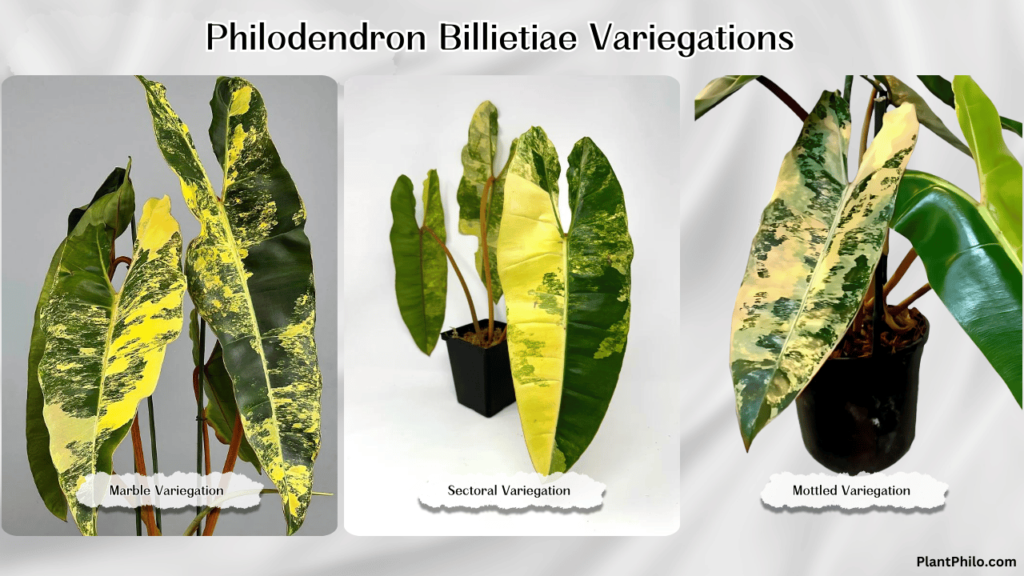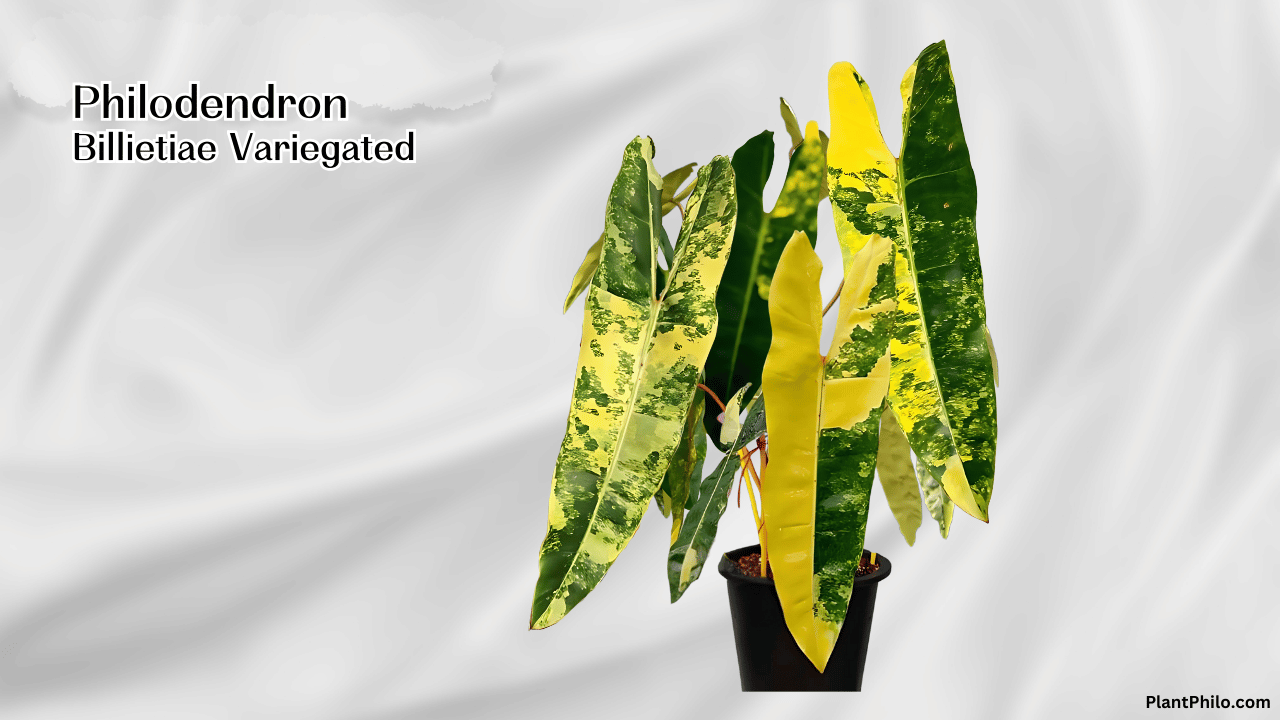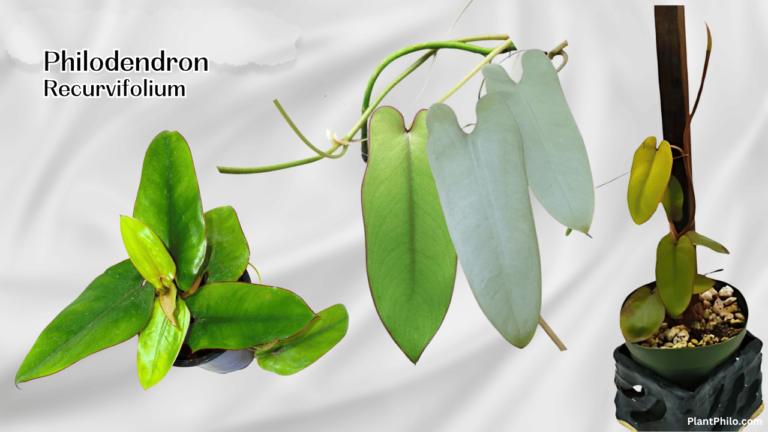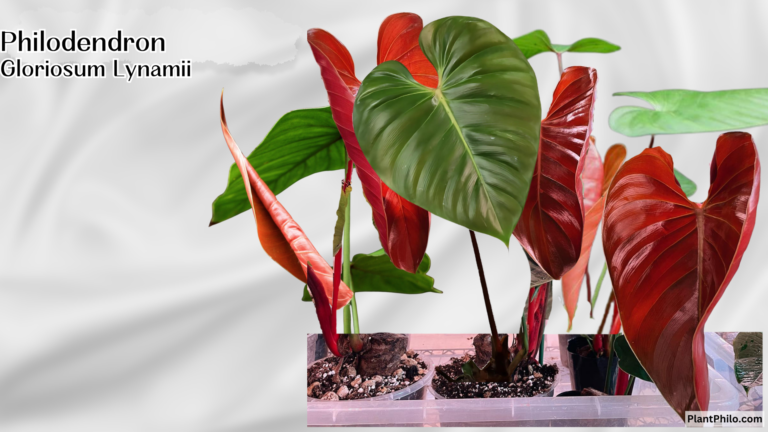Variegated Philodendron Billietiae: A Rare Gem for Plant Collectors
People who love collecting plants will love Variegated Philodendron Billietiae. It has a beautiful, rare variegation and the unique form and growth pattern of its parent species. It is different from other aroids because its leaves are long and have bright white, yellow, or pink stripes running through them.
Even though its beautiful look gets a lot of attention, it also has some problems. To take care of this plant, you need to know more than just the basics of houseplant maintenance. For example, you need to make sure it gets enough light for the variegation and keep it from turning back to green.
Due to its high price and limited supply, Variegated Philodendron Billietiae is often out of reach for many people because it is so rare and highly sought after. For people who are lucky enough to find this amazing plant, it will make any indoor jungle look amazing. But this plant needs extra care to grow well, even though it is very pretty.
We’ll talk about what makes the Variegated Philodendron Billietiae so unique, look at its different colors, and give you all the care tips and data-driven insights you need to take good care of this rare beauty.
What is Variegated Philodendron Billietiae?
The Philodendron Billietiae is known for its long, arrow-shaped leaves that are a bright green color and its long, orange-red petioles that make it stand out. This plant is already very impressive, but the variegated form takes it to a whole new level with beautiful splashes of creamy white, yellow, and sometimes even orange on its leaves.
Different colors show up in plants because of a genetic change that leaves some cells lacking chlorophyll, the pigment that makes photosynthesis possible. Because of this, parts of the plant that have different colors often look white or yellow.
Although this makes the plant look beautiful, it also makes the Variegated Philodendron Billietiae more fragile and needs more care than the non-variegated type.
Variegated Philodendron Billietiae: At a Glance
| Feature | Details |
| Scientific Name | Philodendron billietiae variegata |
| Origin | Hybrid cultivar (variegated form of Philodendron billietiae) |
| Growth Habit | Climbing/Vining |
| Leaf Shape | Elongated, lance-shaped to paddle-shaped |
| Leaf Color | Green with varying degrees of white, cream, or yellow variegation |
| Light Needs | Bright, indirect light |
| Water Needs | Allow soil to dry out slightly between waterings |
| Humidity | Moderate to high humidity (50-70%) |
| Soil | Well-draining, airy mix rich in organic matter |
| Fertilizer | Balanced liquid fertilizer during the growing season |
| Propagation | Stem cuttings |
| Pests & Diseases | Susceptible to common houseplant pests and root rot if overwatered |
| Toxicity | Toxic to pets and humans if ingested |
Mystery behind the variegated Philodendron Billietiae:
The Chimera Mutation
Philodendron Billietiae has different colors because of a rare cell change at the meristems, which are growth hubs where new cells are made.
Specifically, it’s a sectorial chimera. Fancy term, right? Essentially, it means that certain cells in the affected area don’t produce chlorophyll (the green pigment) or produce it in lesser amounts
Random Color Play
The variegated Billietiae’s leaves are like a botanical kaleidoscope. They flaunt shades ranging from deep green to chartreuse, yellow, and cream.
There’s more, though! The leaf stems, or petioles, also show up; they’re a bright orange color. The plant seems to have chosen to hold its own tropical party.
Sunlight Is Important
Light takes center stage, which is the secret sauce.
When your Billietiae hangs out in low light, it might produce more green leaves with less variegation. It’s like the plant whispering, “Hey, let’s blend in a bit.”
To amp up the variegation, give it bright, indirect light. Think of it as the plant’s VIP pass to the sun-kissed lounge. But—plot twist—avoid direct sunlight; it’s like a leafy sunburn.
The Patience
Taking care of a variegated Billietiae is similar to tending to a fragile beauty. Some philodendrons grow quickly, but this one is more like a slow, leafy dance.
So wait, look at those swirls of color, and let your plant show you its creation.
Remember that each variegated leaf is a living painting that makes your room brighter. Make sure that Billietiae is happy, and who knows what might happen?
Different Variegation Types in Philodendron Billietiae
One of the most fascinating aspects of Variegated Philodendron Billietiae is the variety of variegation patterns it can develop.
Each plant is unique, with some exhibiting more stable patterns than others. Here are the main variegation types found in this species:

1. Marble Variegation
The variegation appears in the form of marble-like streaks across the leaf surface. This creates a blend of colors, with the variegation mixing into the green in a more unpredictable pattern. Marble variegation is typically more stable and less prone to reverting back to green.
2. Sectoral Variegation
This type features larger, block-like patches of variegation, often covering entire sections of a leaf. In some cases, nearly half of the leaf can be variegated, producing a dramatic contrast between the green and variegated sections.
3. Mottled Variegation
Mottled variegation appears to be tiny speckles or spots scattered across the leaf. This type of variegation is less common in Philodendron Billietiae but offers a subtle, speckled look that can be very attractive.
Each variegation pattern requires slightly different light conditions to maintain. The more variegation present on a plant, the more sunlight it typically needs, as the plant has less chlorophyll to convert light into energy. Therefore, we must balance light levels to prevent direct sunlight from scorching the leaves of the plant.
Caring for Variegated Philodendron Billietiae
Like all variegated plants, Variegated Philodendron Billietiae has specific care needs that go beyond the basics. Understanding these needs will help ensure that the plant maintains its variegation while growing as healthily as possible.
1. Light
Light is crucial for maintaining the variegation in Philodendron Billietiae. Without enough light, the plant will start to revert to its green form in an attempt to photosynthesize more efficiently.
- Optimal Light: Bright, indirect sunlight is the ideal condition for Variegated Philodendron Billietiae. East or north-facing windows are often best. If natural light is insufficient, consider using grow lights to supplement.
- Avoid Direct Sunlight: Direct sunlight can easily burn the variegated parts of the leaves, as they lack the chlorophyll needed to protect against sun damage.
2. Watering
Balancing the right watering schedule is essential, as overwatering or underwatering can stress the plant and affect its growth.
- Watering Frequency: Water when the top 2–3 inches of soil have dried out. Overwatering can cause root rot, particularly for plants with slower growth, such as Variegated Philodendron Billietiae.
- Humidity Needs: Being a tropical plant, it thrives in high humidity (around 60–80%). Using a humidifier, or placing it near other plants, can help increase local humidity levels.
3. Soil and Potting
Well-draining soil is a must for the Variegated Philodendron Billietiae. Using a mix that allows for adequate aeration and drainage will help prevent root issues.
- Soil Mix: A mix of orchid bark, perlite, and peat moss is ideal. This combination provides the right balance of moisture retention and drainage.
- Repotting: Perform repotting every 1–2 years or when the plant experiences root-bound conditions. Given its slow growth, frequent repotting isn’t necessary.
4. Fertilization
Fertilizing your variegated Philodendron Billietiae will ensure it has the nutrients needed to support healthy variegation.
- Best Fertilizer: Use a balanced liquid fertilizer during the growing season (spring and summer). Be cautious not to overfertilize, as this can lead to leaf burn or reduced variegation.
5. Pruning and maintenance
Regular pruning isn’t necessary for this plant, but it’s important to remove any yellowing or damaged leaves to encourage new growth.
Common Problems and Solutions
Even with careful attention, the Variegated Philodendron Billietiae may face issues. Here are some of the most common problems:
1. Reverted Growth
When new leaves start to emerge without variegation, it’s called reverting. This usually happens if the plant isn’t receiving enough light.
- Solution: Move the plant to a brighter location to encourage variegation to return.
2. Pest Infestations
Like most houseplants, the Variegated Philodendron Billietiae can be susceptible to pests such as spider mites, mealybugs, and aphids.
- Solution: Inspect your plant regularly and treat infestations with insecticidal soap or neem oil as soon as they’re detected.
3. Root Rot
Overwatering and poorly draining soil can lead to root rot, which can quickly kill the plant if not addressed.
- Solution: Ensure the plant’s pot has drainage holes, and allow the soil to dry out slightly between watering.
Propagation of Variegated Philodendron Billietiae
Propagating Variegated Philodendron Billietiae can be a rewarding process, but it’s also more challenging than propagating a non-variegated variety. Since variegation can be unstable, not all propagated cuttings will retain their variegated patterns.
1. Stem Cuttings
Stem cuttings are the most common method of propagating Variegated Philodendron Billietiae.
- Steps:
- Cut a healthy stem just below a node.
- Place the cutting in water or directly into moist soil.
- Ensure the cutting receives bright, indirect light while it roots.
Once roots have developed, usually after several weeks, the cutting can be transferred to a pot with well-draining soil.
2. Air Layering
For a more reliable propagation method, air layering can encourage the plant to produce roots while still attached to the parent plant.
- Steps:
- Select a healthy section of the stem and wrap it in damp sphagnum moss.
- Cover the moss with plastic wrap to retain moisture.
- After a few weeks, once roots have developed, cut the stem below the moss and pot the new plant.
Loosing variegation in your Philodendron Billietiae?
Causes
1. Insufficient Light:
The most common cause. Variegation often results from less chlorophyll, which is essential for photosynthesis. In low light, the plant may produce more chlorophyll to compensate, leading to greener leaves.
2. Genetics:
Some variegation patterns are unstable. As the plant grows, it may revert to a less variegated form.
3. Age:
Older plants may naturally produce less variegated leaves.
4. Nutrient Deficiencies:
While less common, deficiencies in certain nutrients can impact variegation.
Solutions
1. Increase Light Exposure:
Gradually move your plant to a brighter location, ensuring it receives bright, indirect light. Avoid direct sunlight, which can burn the leaves. A study published in the “Journal of Plant Physiology” showed that increasing light intensity can promote variegation in some species.
2. Rotate Plant Regularly:
Turning the plant periodically ensures that all sides receive equal light exposure, preventing the plant from leaning toward the light source and potentially losing variegation.
2. Prune Less Variegated Growth:
Carefully prune any stems or leaves that are showing less variegation. This will redirect the plant’s energy towards producing more variegated growth. A study in “Scientia Horticulturae” demonstrated that pruning less variegated shoots can encourage the growth of more variegated ones.
3. Nutrient Supplementation:
Ensure your plant is receiving a balanced fertilizer formulated for foliage plants. Pay attention to micronutrients like magnesium and iron, which can impact chlorophyll production. Research in “Plant and Soil” suggests that adequate nutrient levels are essential for maintaining variegation.
4. Propagation:
If your plant has a few highly variegated stems, consider taking cuttings and propagating them. These new plants are more likely to maintain their variegation. A study in “Plant Cell, Tissue and Organ Culture” showed that propagating from highly variegated cuttings can help preserve variegation.
5. Maintain Optimal Temperature:
Philodendrons thrive in warm temperatures between 65-85°F (18-29°C). Consistent temperatures can help maintain healthy growth and variegation.
6. Increase Humidity:
These plants prefer higher humidity levels. Misting the leaves regularly, using a humidifier, or placing the plant on a pebble tray filled with water can help create a humid environment.
7. Ensure Proper Drainage:
Ensure that the potting mix has good drainage to prevent root rot. Overwatering can lead to nutrient deficiencies and reduced variegation.
Important Considerations
- Patience: It may take time to see improvement. Be consistent with your care and monitor your plant’s response.
- Genetics: Some variegation patterns are inherently unstable. While you can encourage variegation, you may not be able to fully restore it to its original state.
- Monitor for Pests and Diseases: Regularly check your plant for pests and diseases, as these can affect its health and variegation.
- Stress: Avoid stressing your plant with sudden changes in environment or care. Stress can negatively impact variegation.
- Experiment and Observe: Try different techniques to see what works best for your plant. Keep track of your observations to determine the most effective methods for increasing variegation.
Remember
- Each plant is unique. Observe your Philodendron Billietiae closely and adjust your care based on its specific needs.
- Consult with a local horticultural expert or plant society for further advice tailored to your region and specific cultivar.
Frequently Asked Questions
Why is my Variegated Philodendron Billietiae losing its variegation?
This can happen due to low light conditions. Make sure your plant gets enough bright, indirect light to maintain its stunning variegation.
How often should I repot my Variegated Philodendron Billietiae?
Repot every 1-2 years or when the roots become overcrowded. Spring is the ideal time for repotting.
Can I grow my Variegated Philodendron Billietiae outdoors?
Yes, but only in tropical or subtropical climates with high humidity and filtered light. Protect it from direct sunlight and extreme temperatures.
Why are the new leaves on my Variegated Philodendron Billietiae smaller than the older ones?
This could be due to several factors like insufficient light, nutrient deficiencies, or the plant adjusting to a new environment.
What are the signs of overwatering in a Variegated Philodendron Billietiae?
Yellowing leaves, mushy stems, and a foul odor from the soil are all signs of overwatering. Let the soil dry out a bit between waterings.
Can I propagate my Variegated Philodendron Billietiae from a leaf cutting?
Unfortunately, no. You need a stem cutting with at least one node for successful propagation.
Is the Variegated Philodendron Billietiae rare?
Yes, it is a rare and highly sought-after plant due to its unique variegation.
Where can I buy a Variegated Philodendron Billietiae?
Look for reputable sellers specializing in rare aroids. Be prepared to pay a premium price for this beauty!
How fast does the Variegated Philodendron Billietiae grow?
With proper care, it can exhibit moderate to fast growth, especially during the growing season.
What’s the difference between Philodendron Billietiae and Philodendron Billietiae Variegated?
The Variegated Billietiae has stunning white, cream, or yellow variegation on its leaves, while the regular Billietiae has solid green leaves.




